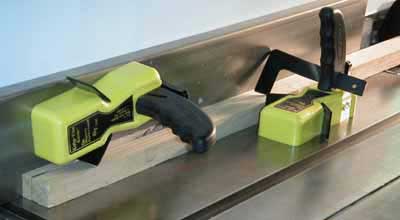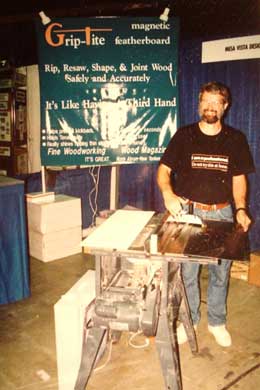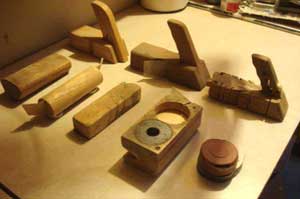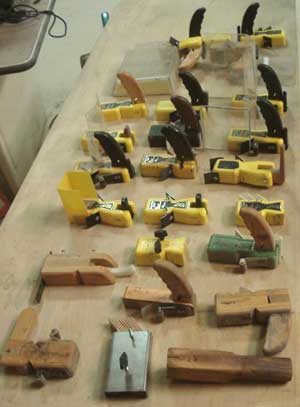
Necessity may be the mother of many inventions, but in the case of Grip-Tite Magnetic Featherboards, adversity also proved to be a strong motivator.
Around 1980, Jerry Jaksha was in the process of building his second house when a table saw calamity nearly shortened his nose – and potentially his life.
“I was ripping a heavy piece of construction lumber, and as the wood exited the saw, it tipped over my sawhorse that was serving as a roller stand. I decided to just push the board the rest of the way through without outfeed support, but I soon realized that the wood was too heavy to manage with just the push stick. And so, I ‘did the dance’ of walking around the saw to help pull the wood through from behind. I didn’t have an extension wing on the saw, so I was basically working right over the blade. When I tried to scoot around to grab the wood, the blade caught the drawstring of my sweatshirt hood. In a split second, the string wound around the arbor and slammed my forehead against the rip fence, with my nose nearly touching the blade. A featherboard and a hold-down could have prevented that accident from happening,” Jerry recalls.
But Jaksha’s inspiration for a better featherboard didn’t come until more than 10 years later. In the interim, Jerry was running a solar business in Nebraska and then in New Mexico that manufactured a motorized insulating shade he had invented and patented. Then, the cost of natural gas declined, and so did his market for energy-saving shades. When his solar business finally came to an end, it was time to come up with a new invention – and a new business direction.
“I tried to get a job with Woodworker’s Supply in Albuquerque to do computer design work for them. While thumbing through their catalog, I paused at featherboards and figured there had to be a better way to clamp them down. Then shortly thereafter, I happened to set a speaker magnet down on my table saw. When it stuck in place, I had my ‘Aha’ moment! There was my solution.”
And so the inventor went back to the proverbial drawing board. Six months and about 70 iterations later, Jerry had a workable prototype: a wood-bodied featherboard with flexible side wings and a top-mounted hold-down. A tall handle enabled him to install the new Grip-Tite on a table saw with just one hand in a matter of seconds. But, more importantly, Jerry had figured out how to direct the magnetic force of a high-energy ceramic magnetic down into a saw table so that it wouldn’t slide sideways when locked in place. He calls it a “focused” magnetic assembly, and it enables his featherboards to apply between 50 and 60 lbs. of sideways force to hold workpieces in place. That breakthrough feature has been the heart of Grip-Tite Featherboard design ever since.
Still, even a clever safety product needs to be marketed in order to be commercially successful. So, Jerry set up a production shop in his garage, enlisted the help of some neighbors and started making featherboards – 250 of them on the first run. With just enough money for plane tickets, he and his wife Sher boxed them up and headed to the 1990 International Woodworking Fair (IWF). It was time to see if a magnetic featherboard could capture some attention.
“I didn’t even have a booth at that first show, and my wife and I slept in our rental car. I would take my Grip-Tites up to other vendors’ booths and demonstrate how they worked. To our amazement, woodworkers began to line up – sometimes 30 guys deep – to buy them. I was getting offers from investors, and Highland Hardware placed an order right on the spot. We ended up selling 450 Grip-Tites at that first IWF. Then I really knew I was on to something good!”
That first woodworking show has led to many, many more since. Jerry says that, aside from the important demonstration purposes and publicity that woodworking shows provide, they also serve as a great acid test for how well your product actually works.
“I’ve calculated that I’ve ripped over 20 million lineal feet of wood during woodworking shows, demonstrating my featherboards,” Jerry admits with some astonishment.
And, road time on the show circuit has led to some important enhancements to Grip-Tite design. The wooden body was eventually changed to ABS plastic. It corrected the occasional problem of the jig’s wood swelling across the grain in humid environments, which reduced the contact force of the magnet. The company also eventually created a steel plate that can be mounted to a rip fence. It enables Grip-Tites to be clamped vertically as hold-downs in addition to the usual horizontal position alongside the fence.
Jerry now sells a Grip-Tite Pro series featherboard with twice as many magnets that distribute the magnetic force over a wider surface. That way, it can be positioned right over a miter slot or adjacent to the throatplate and still hold securely. And now, Grip-Tite makes a sandpaper roller accessory that mounts to the featherboard at an angle. It drives workpieces tight to the fence during ripping so it functions like a manual feed roller. The Rollerguide™, which can be retrofitted to any Grip-Tite featherboard, also makes it easier to rip narrow workpieces as well as plywood and other sheetstock.
Over the years, more than 250,000 Grip-Tite Featherboards have made their way into woodworking shops all across the country and in Canada. They are carried by some 200 specialty stores and retailers, including Rockler Woodworking and Hardware. Jerry also reports that Grip-Tite products are made entirely in the U.S. But, despite the success of their magnetic featherboard products, the Jakshas are happy to keep the New Mexico-based company small. There are only four full-time employees and a few independent contractors. Sher oversees the books, and daughter Summer is the office manager.
This year marks three decades since that first table saw sweatshirt incident. Have there been any other “close calls” that have inspired new product designs? Jerry didn’t divulge any other shocking mishaps—but he did admit, “The memory of seeing that blade spinning right in front of my eyes still gives me the chills.” Understandably. Maybe that’s why this year he’s rolling out a new blade guard product that will fit on the featherboard…just in case.










